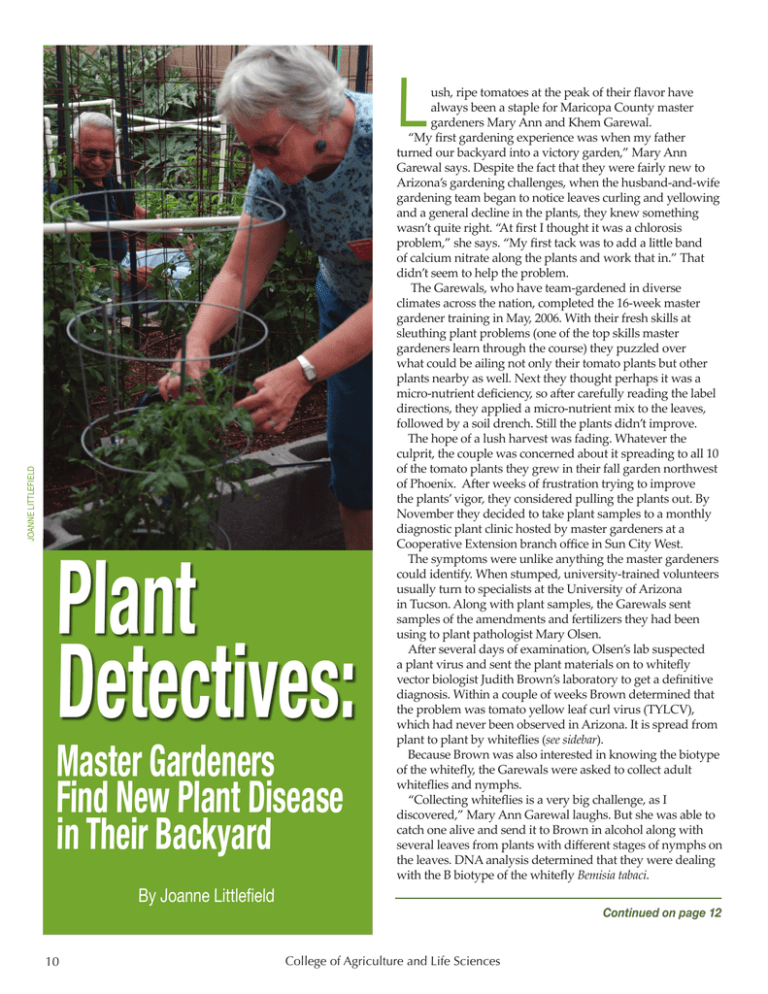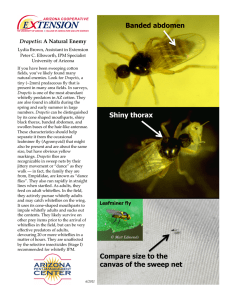L
advertisement

JOANNE LITTLEFIELD L Plant Detectives: Master Gardeners Find New Plant Disease in Their Backyard ush, ripe tomatoes at the peak of their flavor have always been a staple for Maricopa County master gardeners Mary Ann and Khem Garewal. “My first gardening experience was when my father turned our backyard into a victory garden,” Mary Ann Garewal says. Despite the fact that they were fairly new to Arizona’s gardening challenges, when the husband-and-wife gardening team began to notice leaves curling and yellowing and a general decline in the plants, they knew something wasn’t quite right. “At first I thought it was a chlorosis problem,” she says. “My first tack was to add a little band of calcium nitrate along the plants and work that in.” That didn’t seem to help the problem. The Garewals, who have team-gardened in diverse climates across the nation, completed the 16-week master gardener training in May, 2006. With their fresh skills at sleuthing plant problems (one of the top skills master gardeners learn through the course) they puzzled over what could be ailing not only their tomato plants but other plants nearby as well. Next they thought perhaps it was a micro-nutrient deficiency, so after carefully reading the label directions, they applied a micro-nutrient mix to the leaves, followed by a soil drench. Still the plants didn’t improve. The hope of a lush harvest was fading. Whatever the culprit, the couple was concerned about it spreading to all 10 of the tomato plants they grew in their fall garden northwest of Phoenix. After weeks of frustration trying to improve the plants’ vigor, they considered pulling the plants out. By November they decided to take plant samples to a monthly diagnostic plant clinic hosted by master gardeners at a Cooperative Extension branch office in Sun City West. The symptoms were unlike anything the master gardeners could identify. When stumped, university-trained volunteers usually turn to specialists at the University of Arizona in Tucson. Along with plant samples, the Garewals sent samples of the amendments and fertilizers they had been using to plant pathologist Mary Olsen. After several days of examination, Olsen’s lab suspected a plant virus and sent the plant materials on to whitefly vector biologist Judith Brown’s laboratory to get a definitive diagnosis. Within a couple of weeks Brown determined that the problem was tomato yellow leaf curl virus (TYLCV), which had never been observed in Arizona. It is spread from plant to plant by whiteflies (see sidebar). Because Brown was also interested in knowing the biotype of the whitefly, the Garewals were asked to collect adult whiteflies and nymphs. “Collecting whiteflies is a very big challenge, as I discovered,” Mary Ann Garewal laughs. But she was able to catch one alive and send it to Brown in alcohol along with several leaves from plants with different stages of nymphs on the leaves. DNA analysis determined that they were dealing with the B biotype of the whitefly Bemisia tabaci. By Joanne Littlefield 10 Continued on page 12 College of Agriculture and Life Sciences it was confirmed that they also had been stunted by TYLCV. After the virus was definitively diagnosed and Brown had all the plant material and whiteflies she needed, the Garewals were instructed to destroy their plants by uprooting them, bagging them up in black plastic and disposing of them. “We were not advised to do anything with the soil, because the virus is not soil-borne,” says Mary Ann Garewal. She and her husband continue to grow vegetables and herbs in those planting beds, with no ill effects. The Garewals and fellow master gardeners got a valuable front-line experience in what it takes to be a plant detective. “We learned to pursue anything that’s unusual, to really pursue it,” Mary Ann Garewal says. They also learned how pervasive a plant disease can be, especially when compounded with the spread by tiny elusive insects. ❖ JOANNE LITTLEFIELD “When we bought the plants from the nursery they showed no sign of whiteflies, no whitefly damage and no whitefly eggs, which of course are very hard to see and would be easy to miss on plants,” Mary Ann Garewal notes. Once the plant disease was identified the Garewals began to worry about the disease spreading and just how widespread the problem could become. Mary Ann Garewal began to ask garden centers and fellow gardeners about the problem. “I talked to everyone I knew who grew tomato plants and didn’t come up with anybody until one day I was talking to an acquaintance, and I said, ‘how is your garden growing?’ The woman, who lived 14 miles away, commented, ‘I have this funny problem with the leaves curling and yellowing.’” “When I asked her that question I didn’t even know if she grew tomatoes,” Mary Ann Garewal says. When plant samples were analyzed in Brown’s lab, PLANT DIAGNOSTIC CLINIC Maricopa County master gardeners host a free monthly plant diagnostic clinic at the Property Owners and Resident Association (PORA) office in Sun City West. Open to the public, the clinic is held the first Thursday of the month from 10:00 a.m. until noon. In addition to the clinic, trained master gardeners also answer walk-in and telephone plant-related queries at the office five days a week from 9:00 a.m. until 1:00 p.m. JOANNE LITTLEFIELD Contact Northwest Valley Master Gardeners 13815 Camino del Sol Sun City West, AZ 85375 (623) 546-1672 Mary Ann (left) and Khem (right) Garewal continue to grow tomatoes, herbs and other vegetables in northwest Maricopa County. 12 College of Agriculture and Life Sciences




